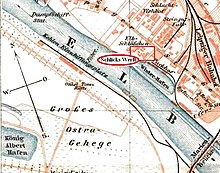Saxon steamship and mechanical engineering institute
The Sächsische Dampfschiffs- und Maschinenbauanstalt was founded in 1872 by converting the shipyard "Maschinen- und Schiffbauanstalt von Otto Schlick", founded by Otto Schlick in Dresden in 1863, into a stock corporation. Shipbuilding continued under the name Dresdener Maschinenfabrik & Schiffswerft AG from 1899 until the company merged with the Übigau shipyard in 1905 .
history
The engineer Otto Schlick founded the machine factory and shipyard on Leipziger Strasse in the Leipzig suburb in 1863/64 and mainly built passenger steamers and wheeled tugs .
1863/64, Otto Schlick founded the machine and shipbuilding company
However, chain tugs No. I, No. IV and No. VI for the chain towing company Oberelbe, Dresden were also successfully delivered. In addition, the chain tug No. II was built in 1872 for the Prague Steam and Sailing Ship Company in Prague.
In November 1864, Schlick asked the city administration to expand his business license, which was previously restricted to shipbuilding and was granted to him in February 1864, to include mechanical engineering and boiler construction. In addition to shipbuilding and marine engineering, orders for land steam engines and transmissions were soon received. The shipyard area was increasingly surrounded by workshops and storage sheds as well as magazines, and a residential building called an official residence was added.
In 1869 Schlick left his shipyard and continued his working life in Prague, Fiume, Kiel and Hamburg.
In 1869, Schlick left his company and appointed Mr. Kellner as the shipyard manager. The shipyard was largely expanded and was in good economic condition. In the meantime, 15 ships had been delivered, mostly tugs up to 54 meters in length.
Conversion into "Saxon Steamship and Mechanical Engineering Establishment"
In 1872 the machine factory and shipyard Otto Schlick was converted into the Saxon Steamship and Mechanical Engineering Company. Up to this point the company had built around 20 ships. In 1873 an own foundry was built, which also accepted external orders and soon enjoyed a very good reputation. The company took part in the Vienna World Exhibition in 1873, received a medal and several orders and was able to sell some of the machines on display, the boiler steam engine and the horizontal steam engine directly on site.
On the Elbe side, the Neustädter Hafen was laid out from 1872 to 1876 . The Saxon Steamship and Mechanical Engineering Institute continued Schlick's construction program. In 1873 and 1874 the rope tugs I and II were delivered to the Deutsche Eisenbahnbau Gesellschaft, Küstrin, under construction numbers 27 and 28. Among other things, the side wheel tugboat Berlin (length: 23.00 m, width: 4.10 m, powered by a steam engine with 250 hp) was built in 1882 for the skipper Strack from Magdeburg.
1884 Takeover by the Austrian Northwest Steamship Company (ÖNWDG)
In 1884 it was taken over by the Österreichische Nordwest Dampfschiffahrts-Gesellschaft, which determined the shipbuilding program from construction number 157. The ships delivered were seldom longer than 50 meters or, as barges, rarely carried more than 400 tons. Shipbuilding declined in 1895 and the company expanded the construction of stationary steam engines. The nominal power was around 50 HP. With increasing electrification, the construction of dynamo machines increased, which had a higher demand on speed control. With the support of the Dresden engineering office Dr. Rudolf Proell, high-speed steam dynamos of the Doerfel-Proell type were built and delivered. In 1887, 10 to 12 of these fixed high-speed machines left the company every year. The rated power of these machines in horizontal or vertical design rose to around 500 hp. Even after 1900 the favorable order situation in steam engine construction continued, but the number of new ships kept it. With the tugboat Kaiser Wilhelm II built for the ÖNWDG in 1902/03, the largest tugboat ever built for the Elbe was delivered.
1899 Dresdener Maschinenfabrik & Schiffswerft, AG Dresden-Neustadt
The ÖNWDG got into a serious crisis, as the general director Otto Libbertz had speculated in sugar for his own benefit but on behalf of the company together with a Bohemian sugar factory and the Commerz- und Privatbank. As a result of the judicial review, the ÖNWDG had to satisfy high claims for damages in the millions and became a restructuring case. As part of the restructuring that followed, the "Sächsische Dampfschiffs- und Maschinenbauanstalt" became the "Dresdener Maschinenfabrik & Schiffswerft, AG Dresden-Neustadt", which in 1905 took over the Übigau shipyard .
1905 Dresdener Maschinenfabrik & Schiffswerft Übigau, public limited company
After taking over the factory buildings and shipyards of the "Chain - Deutsche Elbschiffahrts-Gesellschaft" , which is known for short as the "chain", the "Dresdener Maschinenfabrik & Schiffswerft Übigau, Aktiengesellschaft" was created. Shipbuilding in Dresden-Neustadt was discontinued and relocated to Übigau, making the shipyard one of the largest river and inland waterway shipyards of the time.
literature
- Sigbert Zesewitz: Shipbuilding on the Elbe . Sax-Verlag, 2006, ISBN 978-3-934544-78-9 , pp. 122 .
- Bertram Kurz, Helmut Düntzsch: Shipyards in Dresden 1855-1945 . Ed .: State Office for Monument Preservation Saxony (= workbook . Volume 6 ). Sax-Verlag, 2004, ISBN 978-3-934544-62-8 .
Web links
- The shipyard on dresden-uebigau.de






